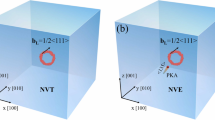Abstract
Deep level transient spectroscopy (DLTS) measurements have been performed on a variety of AlxGa1-xAs p-n junctions prior to and following a series of fast neutron irradiations at room temperature and subsequent isochronal anneals. In contrast with electron and proton irradiated GaAs, neutron irradiation produces a single, broad featureless DLTS band which is a majority carrier trap in both n and p type material. The characteristics of this neutron-induced trap are relatively independent of growth method, dopant type and concentration. In GaAs, the thermal emission energies of the trap are 0.58 to 0.68 eV depending on the particular junction. These energies increase with Al content to 0.94 eV at 20% Al. The trap introduction rate, which also increases with Al content, is 0.7 cm-1 in GaAs. Isochronal annealing to temperatures as high as 400‡C results in a smaller FWHM of the DLTS band, a shift in the peak to higher temperatures, and a modest decrease in magnitude. Above 400‡C the magnitude decreases rapidly, suggesting a similarity with the antisite defect, AsGa, which has been observed to anneal in this range.
Similar content being viewed by others
References
B. L. Gregory, IEEE Trans. Nuc. Sci.NS-16, no. 6, 53 (1969).
L. C. Kimerling and P. J. Drevinsky, IEEE Trans. Nuc. Sci.NS-18, no. 6, 60 (1971).
H. J. Stein, J. Appl. Phys.39, 5283 (1968).
V. C. Burkig, J. L. McNichols and W. S. Ginell, J. Appl. Phys.40, 3268 (1969).
R. J. Chaffin,Microwave Semiconductor Devices: Fundamentals and Radiation Effects (John Wiley, New York, 1972), p. 98.
M. Bertolotti, T. Papa, D. Sette and G. Vitali, J. Appl. Phys.38, 2645 (1967).
D. V. Lang, J. App. Phys.45, 3023 (1974).
D. V. Lang, L. C. Kimerling and S. Y. Leung, J. Appl. Phys.47, 3587 (1976).
A. S. Epstein, S. Share, R. A. Polimadei and A. H. Herzog, IEEE Trans. Nuc. Sci.NS-23, 1654 (1976).
B. L. Gregory and H. H. Sander, IEEE Trans. Nuc. Sci. no. 6, 116 (1967).
R. E. Leadon, IEEE Trans. Nuc. Sci.NS-17, no. 6, 110 (1970).
K. L. Brower,Ion Implantation in Semionductors, 1976, edited by F. Chernow, J. A. Borders, and D. K. Brice (Plenum, New York, 1977), p. 427.
G. M. Martin and S. Makram-Ebeid,12th Inter. Conf. on Defects in Semiconductors, edited by C.A.J. Ammerlaan (North Holland, Amsterdam, 1983).
S. S. Li, W. L. Wang, P. W. Lai, R. Y. Loo, G. S. Kamath and R. C. Knechtll, IEEE Trans, on Electron Devices ED-27, 857 (1980).
G. Vincent, A. Chantre and D. Bois, J. Appl. Phys.50, 5484 (1979).
B. R. Gossick, J. Appl. Phys.30, 1214 (1959).
P. 107 in Ref. 5.
G. C. Osbourn, Phys. Rev. B22, 2898 (1980).
G. M. Martin, P. Secordel and C. Venger, J. Appl. Phys.53, 8706 (1982).
R. Worner, U. Kaufman and J. Schneider, Appl. Phys. Lett.40, 141 (1982).
A. Goltzene, B. Meyer and C. Schwab, J. Appl. Phys.54, 3117 (1983).
G. M. Martin, Appl. Phys. Lett.39, 747 (1981).
S. Makram-Ebeid, D. Gautard, P. Devillard and G. M. Martin, Appl. Phys. Lett.40, 161 (1982).
J. Lagowski, H. C. Gatos, J. M. Parsey, K. Wada, M. Kaminska and W. Walukiewicz, Appl. Phys. Lett.40, 342 (1982).
H. J. Stein, J. Appl. Phys.40, 5300 (1969).
A. Goltzene, B. Meyer and C. Schwab, presented at the 13th International Conf. on Defects in Semiconductors, Aug. 12–17, 1984, Coronado, CA.
B. K. Meyer, D. M. Hoffmann, J. M. Spaeth, and E. Lohse, presented at the 13th international Conf. on Defects in Semiconductors, Aug. 12–17, 1984, Coronado, CA.
Author information
Authors and Affiliations
Rights and permissions
About this article
Cite this article
Barnes, C.E., Zipperian, T.E. & Dawson, L.R. Neutron-induced trapping levels in aluminum gallium arsenide. J. Electron. Mater. 14, 95–118 (1985). https://doi.org/10.1007/BF02656670
Received:
Issue Date:
DOI: https://doi.org/10.1007/BF02656670




